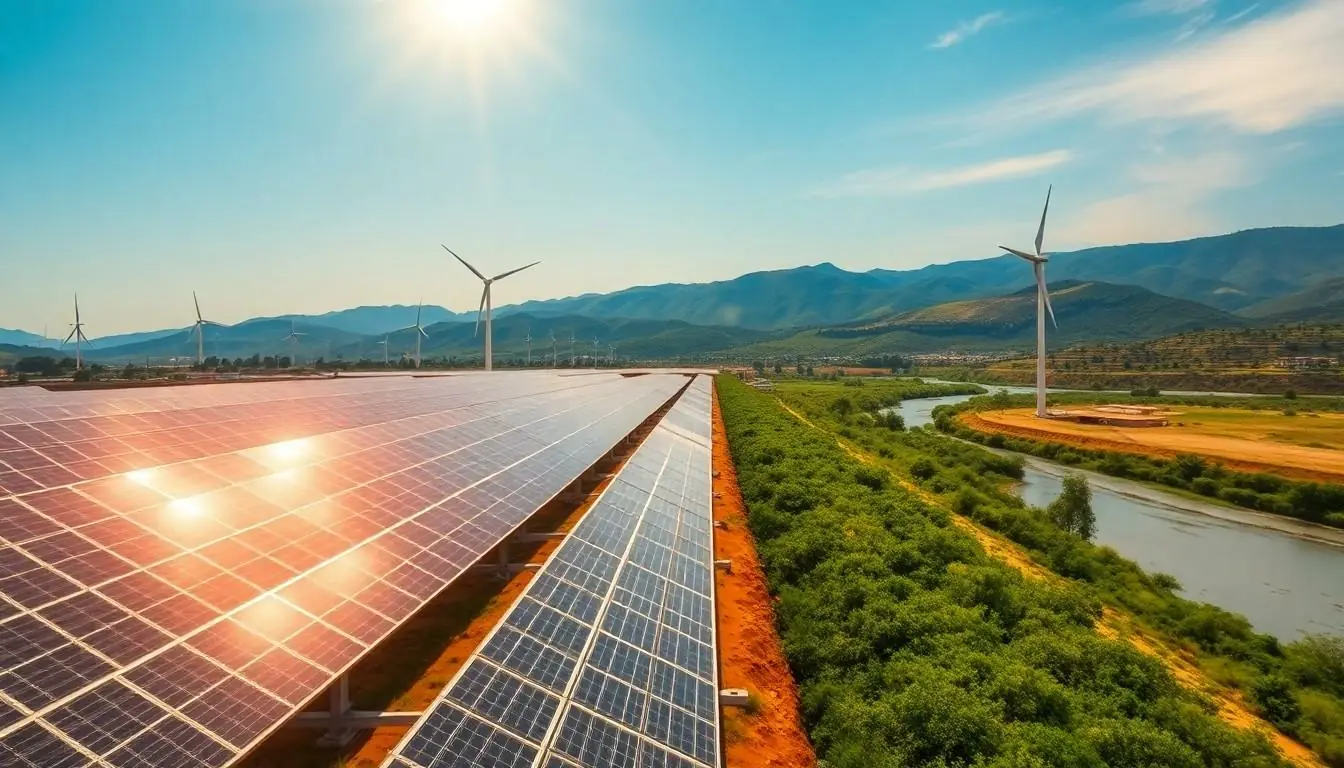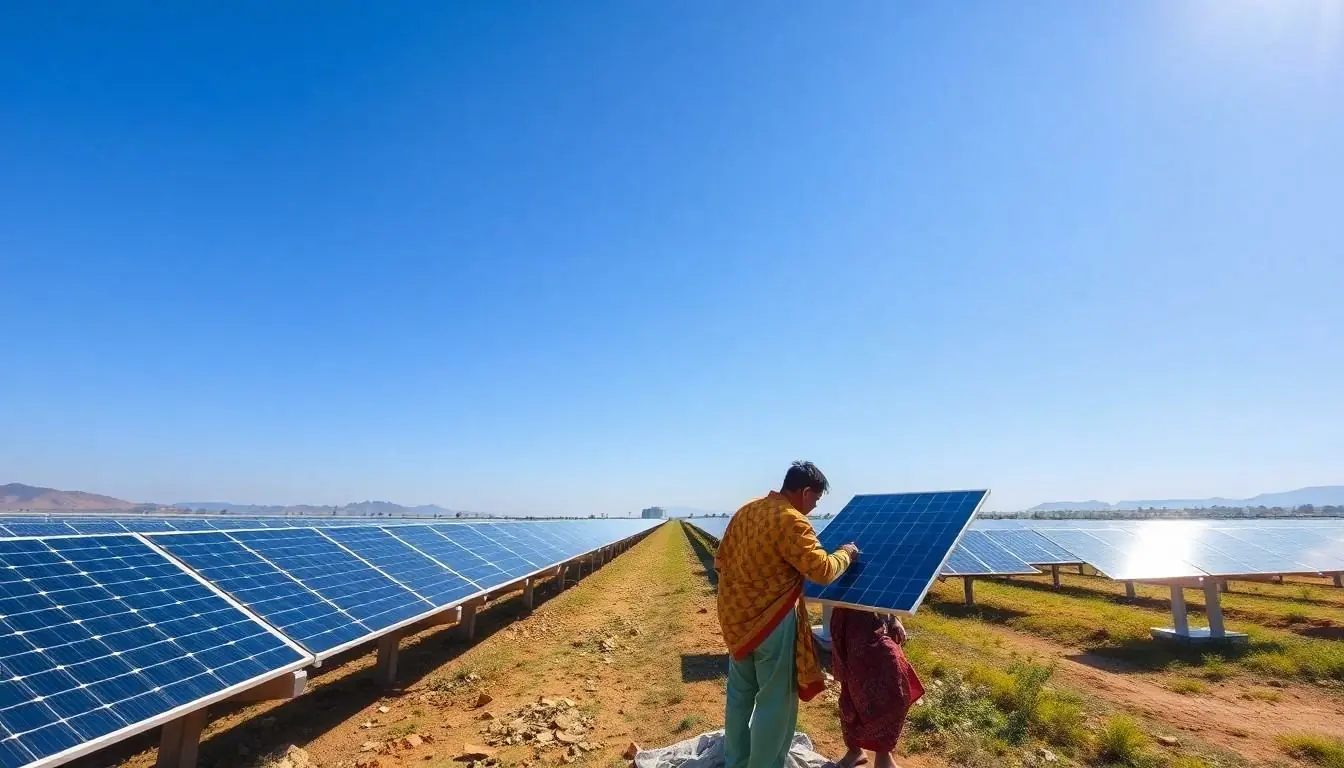South Asia is buzzing with potential, and no, it’s not just the sound of traffic. This vibrant region is home to one of the most important sources of renewable energy: solar power. With sunshine that could make a sunscreen ad blush, South Asia is perfectly positioned to harness this abundant resource. Imagine turning those sun-drenched days into electricity that powers homes, schools, and even your favorite chai stall.
Table of Contents
ToggleOverview of Renewable Energy in South Asia
South Asia showcases a substantial potential for renewable energy sources. Solar power plays a crucial role due to the region’s vast sunlight availability. Countries like India, Bangladesh, and Sri Lanka increasingly invest in solar technology to capitalize on this resource.
Wind energy represents another significant contributor. Coastal areas in India and Sri Lanka offer optimal conditions for wind farms. As of 2023, India ranks among the top five countries globally for installed wind power capacity, exceeding 40 gigawatts (GW).
Hydropower also remains essential in South Asia’s energy mix. With multiple rivers flowing through the region, Nepal and Bhutan have developed significant hydropower projects. These projects contribute to local electricity needs while enabling energy exports to neighboring countries.
Biomass energy provides an alternative source of renewable energy. Rural areas utilize agricultural waste and livestock manure to generate electricity. This approach not only addresses energy demands but also promotes waste management.
Geothermal energy presents additional opportunities. Regions like India’s Himalayan foothills showcase untapped geothermal resources, enriching the renewable landscape. Enhanced research and investment in these areas could lead to substantial energy generation.
Government policies increasingly favor renewable investments. Incentives, subsidies, and supportive regulations aim to reduce fossil fuel dependence. Such measures encourage private and public partnerships, facilitating innovative projects throughout the region.
Overall, South Asia’s renewable energy landscape is diverse and expanding. Emerging technologies and strategic investments contribute significantly to the region’s energy security and sustainability goals.
Types of Renewable Energy Sources

South Asia features a variety of renewable energy sources crucial for its energy landscape. Each type plays a significant role in promoting sustainability and enhancing energy security.
Solar Energy
Solar energy stands out due to South Asia’s abundant sunshine. Countries like India and Bangladesh leverage this resource effectively, generating electricity for homes and local businesses. As investments in solar technology increase, solar farms and rooftop installations expand across urban and rural areas. India leads with ambitious goals, aiming for 100 GW of solar power capacity by 2022, and has consistently made advancements in solar panel technology. This growth not only benefits local economies but also contributes to reducing greenhouse gas emissions.
Wind Energy
Wind energy holds great promise, especially along South Asia’s coasts. India and Sri Lanka take advantage of optimal wind conditions, fostering the development of wind farms. With over 40 GW of installed capacity, India ranks among the top five countries globally in this sector. These wind farms produce clean energy while generating job opportunities for local communities. Additionally, advancements in turbine technology enhance efficiency and reduce costs, ensuring wind energy remains a competitive alternative within the renewable landscape.
Hydropower
Hydropower continues to be a cornerstone of South Asia’s energy mix. In countries like Nepal and Bhutan, large-scale hydropower projects enable not only local electricity fulfillment but also energy exports to neighboring regions. The potential for additional projects remains vast, with many rivers ideal for harnessing water flow. These installations contribute to sustainable development by providing reliable energy while minimizing environmental impacts. Various governments support hydropower initiatives, aiming to improve infrastructure and attract investments for future growth.
Benefits of Renewable Energy in South Asia
Renewable energy offers significant advantages for South Asia, contributing to environmental sustainability and economic growth.
Environmental Impact
Reducing greenhouse gas emissions is a primary benefit of adopting renewable energy sources. Solar and wind power produce no emissions during operation, significantly decreasing air pollution levels. Harnessing hydropower leads to cleaner waterways and supports biodiversity. Preserving natural resources becomes easier through responsible energy production, promoting a sustainable ecological balance. Utilizing biomass energy also helps in managing agricultural waste, turning potential pollutants into valuable resources. Consequently, regions with diverse ecosystems experience improved health and resilience, fostering environmental protection.
Economic Advantages
Fostering job creation is a major economic advantage of renewable energy development. The solar and wind sectors employ millions of workers across South Asian countries. Investments in infrastructure lead to local business growth and stimulate economies. Access to affordable energy promotes increased productivity among industries and facilitates energy independence. Renewable energy technologies often have lower operating costs once established, benefiting consumers with reduced energy bills. Additionally, government incentives attract private investments, driving innovation and technology advancements. The cumulative effect strengthens regional economies and enhances overall energy security.
Challenges Facing Renewable Energy Implementation
Despite the promising potential of renewable energy in South Asia, several challenges impede its implementation. These obstacles require strategic solutions to unlock the region’s energy capabilities further.
Infrastructure Limitations
Infrastructure limitations curtail the growth of renewable energy projects. Aging power grids often struggle to accommodate new energy sources, affecting distribution efficiency. Many remote areas lack access to essential infrastructure, hindering the installation of solar panels and wind turbines. Transporting materials and technology to rural sites proves difficult, raising project costs. Enhancing grid capacity and expanding access to remote regions can address these challenges effectively.
Policy and Regulation Issues
Policy and regulation issues pose significant hurdles for renewable energy development. Inconsistent regulations across countries create uncertainty for investors, leading to hesitance in funding projects. Navigating complex bureaucratic processes delays project approvals and permits. Governments must streamline regulatory frameworks to foster investment and promote collaboration. Establishing clear policies encourages innovation and paves the way for more extensive renewable energy adoption.
Future Prospects for Renewable Energy in South Asia
Innovative advancements in renewable energy technologies offer promising prospects for South Asia. Investment in solar power is set to expand significantly, capitalizing on the region’s abundant sunlight. As the cost of solar panels continues to decline, more communities will likely adopt solar energy solutions. Governments in India, Bangladesh, and Sri Lanka are increasingly prioritizing renewable energy, which fosters growth in the sector.
Strong potential exists for wind energy, particularly in coastal regions. India’s achievements in wind power capacity, currently exceeding 40 gigawatts, exemplify this trend. Local job creation will thrive as new wind farms develop, enhancing sustainable employment opportunities in communities. Comprehensive strategies are necessary to maximize the benefits of wind energy and ensure technological advancements continue.
Hydropower in Nepal and Bhutan has shown effectiveness in meeting local energy demands while also facilitating energy exports. Plans for additional hydropower projects are under consideration, driven by supportive government initiatives that encourage infrastructure development. This trend indicates a robust future for energy independence in the region.
Biomass energy is gaining recognition for its role in waste management by transforming agricultural residue into energy. With rural areas adopting these technologies, both energy access and environmental benefits will increase. Geothermal energy, especially in India’s Himalayan foothills, holds untapped potential that could further diversify the renewable energy portfolio.
Collaborative efforts among governments, private investors, and local communities are crucial for overcoming existing challenges. Streamlining regulations and enhancing grid capacity will enable project approvals and widen access to remote regions. Commitment to investing in renewable energy is vital for sustainable growth, providing South Asia a path toward robust energy security and environmental preservation.
South Asia stands at a pivotal moment in its renewable energy journey. With abundant solar and wind resources alongside significant hydropower potential, the region is poised for a sustainable energy revolution. The commitment from governments and private investors to enhance infrastructure and streamline regulations will be crucial in overcoming existing challenges.
As investments pour into innovative technologies and projects, the prospect of job creation and economic growth becomes increasingly tangible. The shift towards renewable energy not only addresses environmental concerns but also fosters a more resilient energy landscape. By harnessing its diverse energy sources, South Asia can pave the way for a brighter and more sustainable future.





